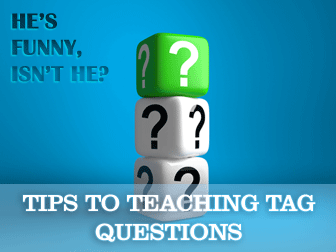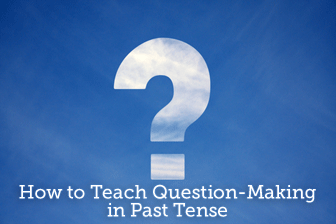Heís Funny, Isnít He? Tips to Teaching Tag Questions


Since past tense is often taught very early on, question-making can be particularly confusing. There are several ways to relieve the confusion and provide students with plenty of leeway for errors.

The first thing to approach is the use of helping verbs (HV). You need to explain when to use ‘did’ and when to use ‘was/were’. Was/were is the past tense of the verb to be. It is used to talk about states of being, emotions, and senses. Did is used in conjunction with an action verb. The helping verb ‘did’ isn’t used in the statement, only in the question and the short answer. The question word or helping verb always goes at the beginning of the question.
| Statement | Question | Explanation |
| I loved him. | Did you love him? | There is no helping verb and there is action: Use did |
| Mario was happy. | Was Mario happy? | Reverse the statement to put the HV in the front |
| James went out. | Did James go out? | There is no helping verb and there is action: Use did |
| They were in trouble. | Were they in trouble? | Reverse the statement to put the HV in the front |
Using question words like who, what, when, where, how and why will elicit a long answer. These are used to draw out information, not simply a yes or a no. They also combine with ‘did’ or the verb ‘to be’ for questions. Using the same examples from above, draw some parallels. Again, if you have the helping verb was/were in a sentence, it will appear in the information question. When there is action and no helping verb in the statement, you need did in the question. A great way to get students thinking about information questions is alter the statements and then have them determine which question word to use, and the word order for the question. Here are some examples:
| Statement | Question |
| I loved him for ten years. | How long did you love him? |
| Mario was happy in Mexico | Where was Mario happy? |
| James went out early this morning. | When did James go out? |
| They were in trouble because they were naughty. | Why were they in trouble? |
You’ll want to incorporate a variety of activities to practice question making in past tense. One useful way to practice past tense verbs along with question creation is any form of memory games. You can utilize pictures or word cards and have the students draw cards until they match. They then have to create questions and sentences using both the verb forms. Another activity to practice question making in past tense it to do some form of activity based on memories. Have students interview one another or do a mingling activity that produces lots of questioning. One way to do this is to simply give the students a theme. For example: childhood friends, vacations, past birthday celebrations. Anything that will get them talking about past experiences. You could even put one student in the “hot seat.” This is when students fire questions at the hot seat student until they can’t think of any more questions. It’s a wonderful way to get students asking and answering questions at a fast pace! No matter what practice activity you choose for creating questions, you will inevitably have the students practicing past tense verbs, time markers and the difference between past and present tenses.
Provide topics that are relevant to the class age group, level, and hobbies, and you can’t go wrong.